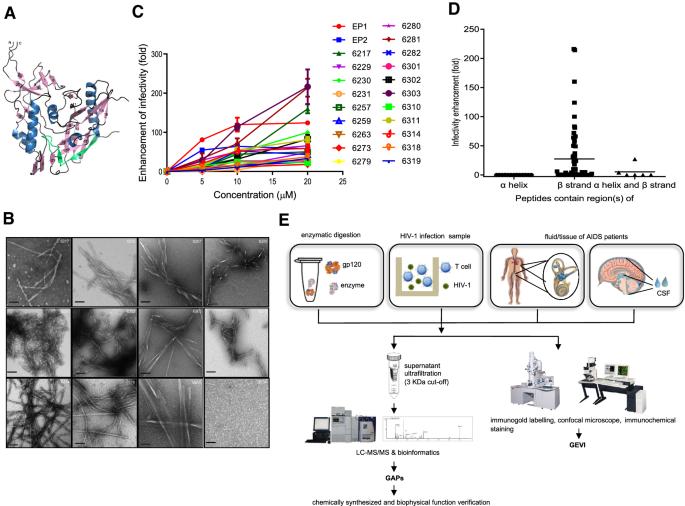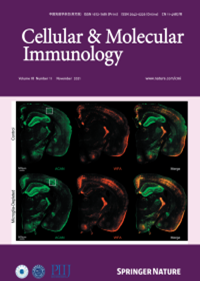gp120 衍生的淀粉样蛋白肽形成的淀粉样纤维会增加 HIV-1 的感染性。
IF 21.8
1区 医学
Q1 IMMUNOLOGY
引用次数: 0
摘要
除了介导病毒进入外,游离 HIV-1 包膜蛋白(gp120)的功能也有待阐明。我们的研究小组先前发现,源自 gp120 中一条 β 链的 EP2 可以形成淀粉样纤维,从而增加 HIV-1 的感染性。重要的是,gp120 含有约 30 条 β 链。我们研究了 gp120 是否可能作为一种前体蛋白,用于蛋白水解释放淀粉样蛋白生成片段,形成淀粉样纤维,从而促进病毒感染。肽阵列扫描、酶降解测定和体外病毒感染实验证实,许多源自gp120的β链肽确实可以形成淀粉样纤维,从而增强HIV-1的感染力。这些经证实能形成淀粉样纤维的 gp120 衍生淀粉样肽或 GAPs 被称为 gp120 衍生病毒感染增强剂(GEVIs)。GEVIs能特异性捕获HIV-1病毒并促进其附着在靶细胞上,从而增强HIV-1的感染力。不同的 GAPs 可以交叉作用形成异质纤维,从而保持提高 HIV-1 感染性的能力。GEVIs 甚至会抑制一系列抗逆转录病毒药物的抗病毒活性。值得注意的是,在艾滋病患者体内的淋巴液、淋巴结和脑脊液(CSF)中发现了内源性 GAPs 和 GEVIs。总之,gp120衍生的淀粉样纤维可能在HIV-1的感染过程中起着至关重要的作用,因此是抗HIV疗法的新靶点。本文章由计算机程序翻译,如有差异,请以英文原文为准。


gp120-derived amyloidogenic peptides form amyloid fibrils that increase HIV-1 infectivity
Apart from mediating viral entry, the function of the free HIV-1 envelope protein (gp120) has yet to be elucidated. Our group previously showed that EP2 derived from one β-strand in gp120 can form amyloid fibrils that increase HIV-1 infectivity. Importantly, gp120 contains ~30 β-strands. We examined whether gp120 might serve as a precursor protein for the proteolytic release of amyloidogenic fragments that form amyloid fibrils, thereby promoting viral infection. Peptide array scanning, enzyme degradation assays, and viral infection experiments in vitro confirmed that many β-stranded peptides derived from gp120 can indeed form amyloid fibrils that increase HIV-1 infectivity. These gp120-derived amyloidogenic peptides, or GAPs, which were confirmed to form amyloid fibrils, were termed gp120-derived enhancers of viral infection (GEVIs). GEVIs specifically capture HIV-1 virions and promote their attachment to target cells, thereby increasing HIV-1 infectivity. Different GAPs can cross-interact to form heterogeneous fibrils that retain the ability to increase HIV-1 infectivity. GEVIs even suppressed the antiviral activity of a panel of antiretroviral agents. Notably, endogenous GAPs and GEVIs were found in the lymphatic fluid, lymph nodes, and cerebrospinal fluid (CSF) of AIDS patients in vivo. Overall, gp120-derived amyloid fibrils might play a crucial role in the process of HIV-1 infectivity and thus represent novel targets for anti-HIV therapeutics.
求助全文
通过发布文献求助,成功后即可免费获取论文全文。
去求助
来源期刊
CiteScore
31.20
自引率
1.20%
发文量
903
审稿时长
1 months
期刊介绍:
Cellular & Molecular Immunology, a monthly journal from the Chinese Society of Immunology and the University of Science and Technology of China, serves as a comprehensive platform covering both basic immunology research and clinical applications. The journal publishes a variety of article types, including Articles, Review Articles, Mini Reviews, and Short Communications, focusing on diverse aspects of cellular and molecular immunology.

 求助内容:
求助内容: 应助结果提醒方式:
应助结果提醒方式:


